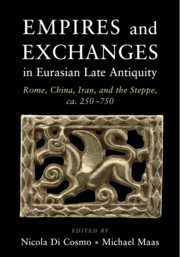72 results
20 - The Mongols and Europe
- from Volume I Part 4 - External Histories
-
-
- Book:
- The Cambridge History of the Mongol Empire
- Published online:
- 01 January 2024
- Print publication:
- 17 August 2023, pp 779-797
-
- Chapter
- Export citation
13 - The Climate and Environment of the Mongol Conquest
- from Volume I Part 2 - Thematic Histories
-
-
- Book:
- The Cambridge History of the Mongol Empire
- Published online:
- 01 January 2024
- Print publication:
- 17 August 2023, pp 603-627
-
- Chapter
- Export citation
1 - Violence in Inner Asian History
- from Part I - Beyond Warfare: Armies, Tribes and Lords
-
-
- Book:
- The Cambridge World History of Violence
- Published online:
- 13 March 2020
- Print publication:
- 26 March 2020, pp 19-37
-
- Chapter
- Export citation
Contributors
-
- Book:
- Empires and Exchanges in Eurasian Late Antiquity
- Published online:
- 13 April 2018
- Print publication:
- 26 April 2018, pp xiii-xiv
-
- Chapter
- Export citation
Glossary of Chinese Terms
-
- Book:
- Empires and Exchanges in Eurasian Late Antiquity
- Published online:
- 13 April 2018
- Print publication:
- 26 April 2018, pp 431-438
-
- Chapter
- Export citation
Preface and Acknowledgments
-
- Book:
- Empires and Exchanges in Eurasian Late Antiquity
- Published online:
- 13 April 2018
- Print publication:
- 26 April 2018, pp xv-xvii
-
- Chapter
- Export citation
Part I - Historical Thresholds
-
- Book:
- Empires and Exchanges in Eurasian Late Antiquity
- Published online:
- 13 April 2018
- Print publication:
- 26 April 2018, pp 17-132
-
- Chapter
- Export citation
Copyright page
-
- Book:
- Empires and Exchanges in Eurasian Late Antiquity
- Published online:
- 13 April 2018
- Print publication:
- 26 April 2018, pp iv-iv
-
- Chapter
- Export citation
Maps and Figures
-
- Book:
- Empires and Exchanges in Eurasian Late Antiquity
- Published online:
- 13 April 2018
- Print publication:
- 26 April 2018, pp xi-xii
-
- Chapter
- Export citation
Bibliography
-
- Book:
- Empires and Exchanges in Eurasian Late Antiquity
- Published online:
- 13 April 2018
- Print publication:
- 26 April 2018, pp 439-486
-
- Chapter
- Export citation
Contents
-
- Book:
- Empires and Exchanges in Eurasian Late Antiquity
- Published online:
- 13 April 2018
- Print publication:
- 26 April 2018, pp vii-x
-
- Chapter
- Export citation
Abbreviations
-
- Book:
- Empires and Exchanges in Eurasian Late Antiquity
- Published online:
- 13 April 2018
- Print publication:
- 26 April 2018, pp xviii-xviii
-
- Chapter
- Export citation
Maps
-
- Book:
- Empires and Exchanges in Eurasian Late Antiquity
- Published online:
- 13 April 2018
- Print publication:
- 26 April 2018, pp xix-xxxviii
-
- Chapter
- Export citation
Part II - Movements, Contacts, and Exchanges
-
- Book:
- Empires and Exchanges in Eurasian Late Antiquity
- Published online:
- 13 April 2018
- Print publication:
- 26 April 2018, pp 133-268
-
- Chapter
- Export citation
Part III - Empires, Diplomacy, and Frontiers
-
- Book:
- Empires and Exchanges in Eurasian Late Antiquity
- Published online:
- 13 April 2018
- Print publication:
- 26 April 2018, pp 269-418
-
- Chapter
- Export citation
Dedication
-
- Book:
- Empires and Exchanges in Eurasian Late Antiquity
- Published online:
- 13 April 2018
- Print publication:
- 26 April 2018, pp v-vi
-
- Chapter
- Export citation
Index
-
- Book:
- Empires and Exchanges in Eurasian Late Antiquity
- Published online:
- 13 April 2018
- Print publication:
- 26 April 2018, pp 487-504
-
- Chapter
- Export citation
2 - The Relations between China and the Steppe
- from Part I - Historical Thresholds
-
-
- Book:
- Empires and Exchanges in Eurasian Late Antiquity
- Published online:
- 13 April 2018
- Print publication:
- 26 April 2018, pp 35-53
-
- Chapter
- Export citation
Introduction
-
-
- Book:
- Empires and Exchanges in Eurasian Late Antiquity
- Published online:
- 13 April 2018
- Print publication:
- 26 April 2018, pp 1-16
-
- Chapter
-
- You have access
- HTML
- Export citation

Empires and Exchanges in Eurasian Late Antiquity
- Rome, China, Iran, and the Steppe, ca. 250–750
-
- Published online:
- 13 April 2018
- Print publication:
- 26 April 2018



